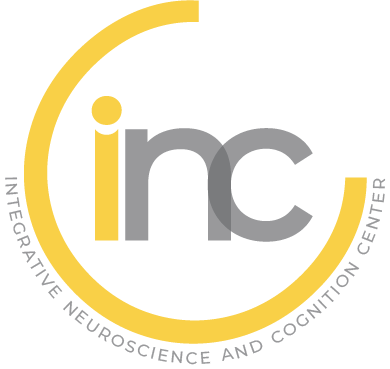Research Axes
The INCC brings together research groups that address the question of how the brain generates its integrative functions, i.e., how it creates the mind and behavior. It gathers researchers who work on all three main targets of neuroscientific research: healthy humans (both adults and infants), patients, (with perceptual, motor, cognitive, psychiatric or neurologic impairments) and animal models. The research topics of the INCC are centered on three axes:
1- Perception, Cognition & Behavior
Almost all teams of the INCC are involved in research on how humans perceive, understand and interact with the environment. The teams that are most active on this axis are the Vision and the Spatial Orientation teams. The Vision team, investigates perceptual processing and how it interacts with other cognitive functions such as action, attention and decision making. It will also study how the cognitive system takes action decisions, choses appropriate actions and automatizes behaviour. The Spatial Orientation team will complement this research by investigating low-level motor functions like multisensory integration, gaze and posture control as well as, not surprisingly, spatial orientation.
2- Development & Plasticity
The teams that are most active on this axis are the Speech & Cognition and the Perception, Action, Cognition (PAC). The Speech & Cognition team studies the acquisition of spoken language. It also studies cognitive functions like the representations of space and quantities, as well as the interaction between language and cognition during development. The Perception, Action, Cognition team investigates the development and plasticity of perception-action and cognition in typical and atypical populations. A big asset of these teams, which makes their research entirely unique, is their collaboration with Paris hospitals (Port Royal, Necker, Bichat) which grants them access to newborns, sometimes only a few hours after birth. In addition, through the Vision and Cognition Unit (Fondation Rothschild, Chokron) the PAC group can run studies in adult and children brain-damaged subjects.
2- Development & Plasticity
The teams that are most active on this axis are the Speech & Cognition and the Perception, Action, Cognition (PAC). The Speech & Cognition team studies the acquisition of spoken language. It also studies cognitive functions like the representations of space and quantities, as well as the interaction between language and cognition during development. The Perception, Action, Cognition team investigates the development and plasticity of perception-action and cognition in typical and atypical populations. A big asset of these teams, which makes their research entirely unique, is their collaboration with Paris hospitals (Port Royal, Necker, Bichat) which grants them access to newborns, sometimes only a few hours after birth. In addition, through the Vision and Cognition Unit (Fondation Rothschild, Chokron) the PAC group can run studies in adult and children brain-damaged subjects.
3- Neurophysiology & Neurological Diseases
Several INCC teams study the neural and glial basis of integrative brain functions as well as their cellular and molecular underpinnings, partially with a particular focus on pathological conditions. The teams most active on this axis are the Cerebral Dynamics, Plasticity, Learning team, the Glia-Glia and Glia-Neuron Interactions team, and the Pathophysiology of Psychiatric Disorders team. These teams investigate amongst others the role of astrocytes and SGC signaling in sensory processing, dynamics and information processing in visual cortex, functions and computations of the cerebellum and the basal ganglia. On the pathological side, they study notably Parkinson’s disease, autism, schizophrenia and depression with the goal of unraveling the synaptic and neural processes that are involved in the diseases.
